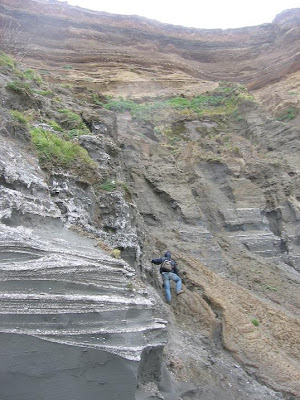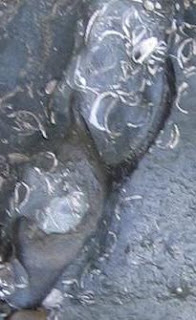
Here local collector Chris Pirrone walks up an exposure of the 10-12 Ma Santa Margarita Sandstone, in the southern Santa Cruz Mountains.

The Santa Margarita Sandstone is locally famous for its abundant fossilized shark teeth that can easily be collected by screening through the sand. Also plentiful are very well preserved sand dollars (Astrodapsis spatiosus), which at this locality are sometimes concentrated into 3-4 meter thick coquinas. C. Pirrone displays a nice Astrodapsis in the above photo. These sand dollars usually occur in the 2-3" range, but at this locality, can measure up to around 5" in diamater.

But we weren't looking for shark teeth or sand dollars. Parts of the Santa Margarita Sandstone have in the past yielded partial and complete skeletons of sea cows and walruses, and cetacean and bird bones. When I took this photo, C. Pirrone (right) and A. Poust (left) had found something neat, they said, but wouldn't tell me what until I made it down the slope to see for myself.

What the heck was it? I was secretly hoping for a partial skull, and realistically thinking it would just be a bone fragment. Instead, I was greeted by the glint of blue enamel in the sunlight; it was a near complete, nearly perfect canine of the 'primitive' walrus, Imagotaria downsi. This is not a major discovery, by far; several complete and partial skulls of this same beast are known from elsewhere in the same formation. After looking through Repenning and Tedford (1977), this specimen appears to be a lower canine from a male I. downsi. Lower canines of many pinnipeds (probably Imagotaria as well) are more curved posteriorly than upper canines. Additionally, there is a large wear facet on the anteriomedial surface, from occlusion with the upper third incisor. More about this later.

Here is a photo of the top of the Santa Margarita Sandstone. It is conformably overlain by the Santa Cruz Mudstone, which you can see here. The orange colored portion near the top of the photo is a brecciated zone of the SC Mdst. The Santa Cruz Mudstone is locally 8-10 Ma (and as young as 6.8-6.0 Ma on the Point Reyes Peninsula).

To check out a shelf of sandstone with a lot of float on it, A. Poust daringly jumped down from above.

A. Poust found a chunk of bone; but it was only a highly abraded, blob-shaped chunk, probably originally a piece of mysticete whale bone. Too bad. Later on and higher up we found several more Imagotaria bones, including a juvenile humerus, and an adult thoracic vertebra. More on this later.




















